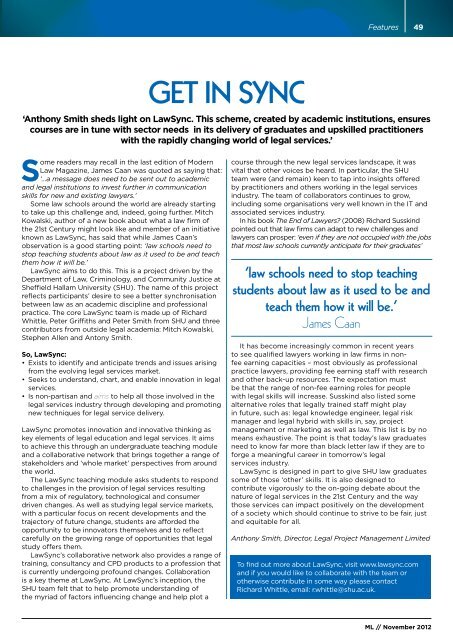Michael Napier
Michael Napier - Modern Law Magazine
Michael Napier - Modern Law Magazine
You also want an ePaper? Increase the reach of your titles
YUMPU automatically turns print PDFs into web optimized ePapers that Google loves.
Features49Get in sync‘Anthony Smith sheds light on LawSync. This scheme, created by academic institutions, ensurescourses are in tune with sector needs in its delivery of graduates and upskilled practitionerswith the rapidly changing world of legal services.’Some readers may recall in the last edition of ModernLaw Magazine, James Caan was quoted as saying that:‘…a message does need to be sent out to academicand legal institutions to invest further in communicationskills for new and existing lawyers.’Some law schools around the world are already startingto take up this challenge and, indeed, going further. MitchKowalski, author of a new book about what a law firm ofthe 21st Century might look like and member of an initiativeknown as LawSync, has said that while James Caan’sobservation is a good starting point: ‘law schools need tostop teaching students about law as it used to be and teachthem how it will be.’LawSync aims to do this. This is a project driven by theDepartment of Law, Criminology, and Community Justice atSheffield Hallam University (SHU). The name of this projectreflects participants’ desire to see a better synchronisationbetween law as an academic discipline and professionalpractice. The core LawSync team is made up of RichardWhittle, Peter Griffiths and Peter Smith from SHU and threecontributors from outside legal academia: Mitch Kowalski,Stephen Allen and Antony Smith.So, LawSync:• Exists to identify and anticipate trends and issues arisingfrom the evolving legal services market.• Seeks to understand, chart, and enable innovation in legalservices.• Is non-partisan and aims to help all those involved in thelegal services industry through developing and promotingnew techniques for legal service delivery.LawSync promotes innovation and innovative thinking askey elements of legal education and legal services. It aimsto achieve this through an undergraduate teaching moduleand a collaborative network that brings together a range ofstakeholders and ‘whole market’ perspectives from aroundthe world.The LawSync teaching module asks students to respondto challenges in the provision of legal services resultingfrom a mix of regulatory, technological and consumerdriven changes. As well as studying legal service markets,with a particular focus on recent developments and thetrajectory of future change, students are afforded theopportunity to be innovators themselves and to reflectcarefully on the growing range of opportunities that legalstudy offers them.LawSync’s collaborative network also provides a range oftraining, consultancy and CPD products to a profession thatis currently undergoing profound changes. Collaborationis a key theme at LawSync. At LawSync’s inception, theSHU team felt that to help promote understanding ofthe myriad of factors influencing change and help plot acourse through the new legal services landscape, it wasvital that other voices be heard. In particular, the SHUteam were (and remain) keen to tap into insights offeredby practitioners and others working in the legal servicesindustry. The team of collaborators continues to grow,including some organisations very well known in the IT andassociated services industry.In his book The End of Lawyers? (2008) Richard Susskindpointed out that law firms can adapt to new challenges andlawyers can prosper: ‘even if they are not occupied with the jobsthat most law schools currently anticipate for their graduates’‘law schools need to stop teachingstudents about law as it used to be andteach them how it will be.’James CaanIt has become increasingly common in recent yearsto see qualified lawyers working in law firms in nonfeeearning capacities – most obviously as professionalpractice lawyers, providing fee earning staff with researchand other back-up resources. The expectation mustbe that the range of non-fee earning roles for peoplewith legal skills will increase. Susskind also listed somealternative roles that legally trained staff might playin future, such as: legal knowledge engineer, legal riskmanager and legal hybrid with skills in, say, projectmanagement or marketing as well as law. This list is by nomeans exhaustive. The point is that today’s law graduatesneed to know far more than black letter law if they are toforge a meaningful career in tomorrow’s legalservices industry.LawSync is designed in part to give SHU law graduatessome of those ‘other’ skills. It is also designed tocontribute vigorously to the on-going debate about thenature of legal services in the 21st Century and the waythose services can impact positively on the developmentof a society which should continue to strive to be fair, justand equitable for all.Anthony Smith, Director, Legal Project Management LimitedTo find out more about LawSync, visit www.lawsync.comand if you would like to collaborate with the team orotherwise contribute in some way please contactRichard Whittle, email: r.whittle@shu.ac.uk.ML // November 2012




